#GROWTHAsia 2021 Highlights: Expert Insights, Key Takeaways and Actionable Strategies

Reading Time: 14 minutes
2020 was an unprecedented year for businesses across geographies, spanning several verticals and industries. In order to provide actionable strategies and bounce-back frameworks to our community of marketers and product owners, we conducted #GROWTHAsia 2020. Continuing our effort of providing top-notch, thought leadership content, we organized #GROWTHAsia 2021, on 24th March 2021, in collaboration with AppsFlyer and Mixpanel.
#GROWTHAsia 2021 consisted of expert panel discussions centered around customer centricity, brand engagement, effective segmentation, leveraging user data, and building a modern engagement stack. The event also shed light on how businesses can drive customer happiness in a mobile-first, post-pandemic world, thus boosting the bottom line.
Our illustrious panel comprised of marketing leaders from Asia’s biggest and most customer-obsessed brands, the likes of POPS Worldwide, OVO, Kredivo, KapanLagi Youniverse, Kompas Gramedia, Amar Bank, Zilingo, U Mobile, NTUC, theAsianparent, Klook, AWS, TM, Chope, AppsFlyer, Tiket.com, and Amanotes.
If you happened to miss out on #GROWTHAsia 2021, don’t worry we got you! In this blog, I will summarise all the interactive and insightful sessions while providing bite-sized key takeaways that you can emulate and grow your business.
Without any further ado, here’s an overview of all the panels and sessions covered during #GROWTHAsia 2021. Let’s jump right in.
Keynote: The Impact of Customer Happiness on Business Revenue
The keynote session of #GROWTHAsia 2021 was spearheaded by Sarika Tulsyan, Chief Revenue Officer at POPS Worldwide. In this session, Sarika talks about the biggest threat to a business in today’s unpredictable environment is not a competition but bad customer experience. She also stresses the need to collaborate and drive customer happiness with a focus on sustainable revenue, i.e. one that reflects the overall business growth and strategy to achieve long-term, organic success.
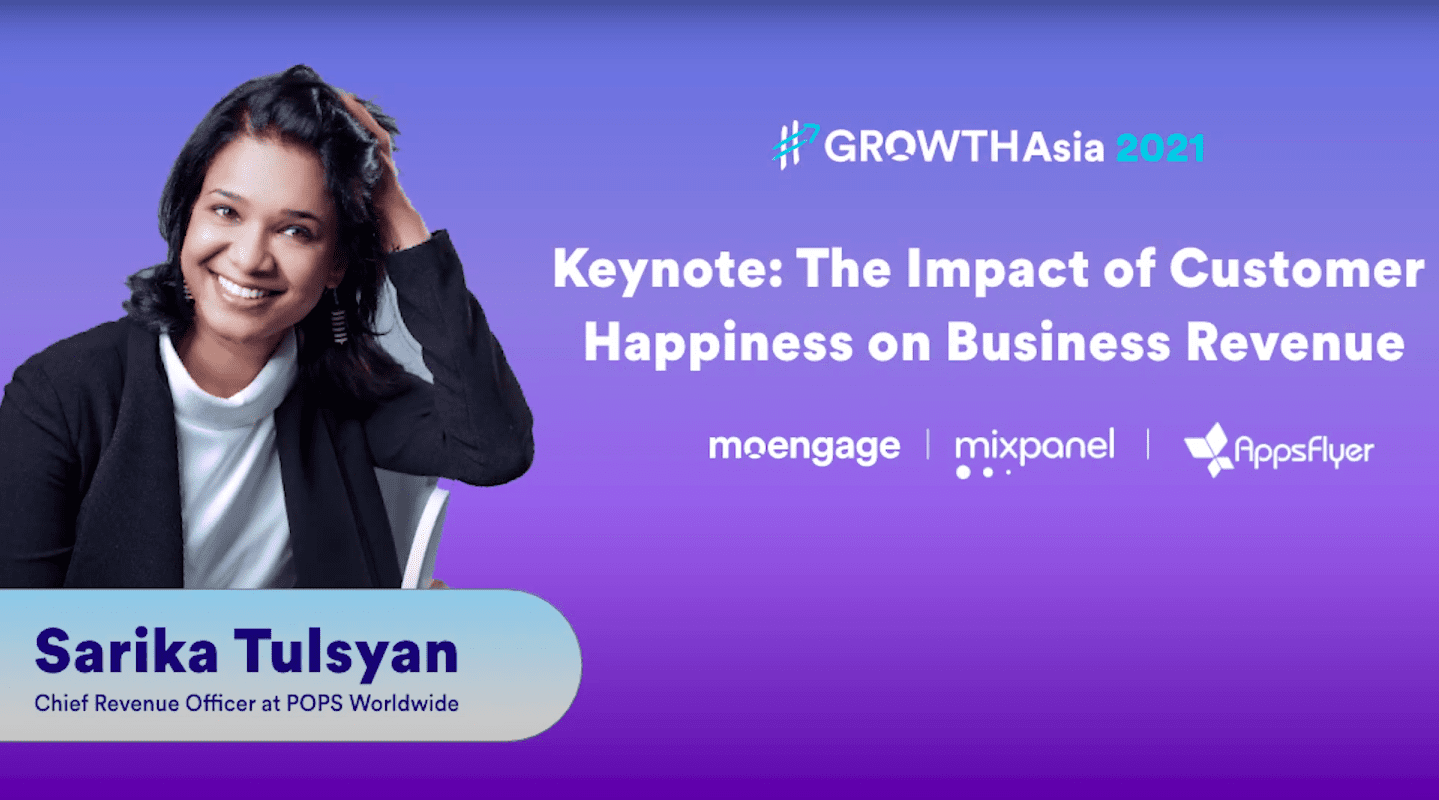
Actionable Takeaways:
- For businesses, it is common knowledge that 80% of the revenue comes from 20% of the business. Since the cost of acquisition is usually higher than the cost of retention, it is critical to understand the difference between customer satisfaction and customer success.
- While customer satisfaction is an efficiency metric, customer success is a revenue metric. Typically, there is always a disproportionate gap between the two. Not every satisfied customer can be regarded as a successful customer. Hence, the number of satisfied customers will always be greater than those who can be considered as successful customers. The real challenge lies in understanding why this gap exists and how to minimize it.
- One way to do this is by considering the multiple metrics across a consumer journey that impact customer satisfaction. In other words, businesses need to focus on the “micro-moments” that lead to a customer’s journey and drive business growth. For instance, for an e-commerce site, the micro-moment could be an offline moment a user experiences (word-of-mouth or a billboard) that triggers them to do an online transaction through a smartphone.
- Understanding these types of micro-moments and leveraging them to drive business growth should be the end goal instead of just looking at the customer journey. This can minimize the customer satisfaction and customer success gap.
Expert Insights:
- Sometimes, over-personalization based on customer segments doesn’t help businesses. For example, a great job of customized content may lead to an increase in conversion and checkout rates, but it may not necessarily lead to higher RPO or average revenue per viewer/user. Why? Because customers are not discovering anything new. Hence, over-personalization might actually be plateauing your business rather than growing it. So, finding the balance between the two is critical.
- As next-gen marketers, it’s our job to drive the business by understanding the next ‘trigger’ that’s informed by data. This also helps acquaint customers with that ‘unknown new’ to enable lasting business growth.
- Organizations tend to define their success metrics in silos for different departments rather than look at it as a common success metric; one which can then cascade into individual departments. Having a common metric can help minimize the gap.
- This can be done by aligning our organization’s goals to department goals with respect to marketing, product, or customer service. Doing this creates a certain level of competencies between the department in terms of defining the clarity and understanding key responsibility towards the goals. When you map those success metrics to department success metrics, you create a harmonious, well-oiled business where everyone is aligned and works towards shared goals, maximizing revenue. In short, the three P’s i.e. People, Process, and Product should be in complete harmony.
- Customer satisfaction metrics are great only if they are being measured by the right people, monitoring the right things, and working towards the big picture. Only then will we as marketers be able to score a victory.
Session 1: Effective Segmentation Strategies to Fuel Customer Engagement
The first session of #GROWTHAsia 2021 was moderated by Divya Jagwani (Senior Manager, SEA, MoEngage) with Agnes Lie (VP of Growth Marketing at OVO), Cahyanto Arie Wibowo (Head of Product Growth at KapanLagi Youniverse), Indina Andamari (VP, Head of Marketing & Communications at Kredivo), Dian Gemiano (CMO at Kompas Gramedia), and Khalid Raheel (CMO at Amar Bank) joining as expert panelists.
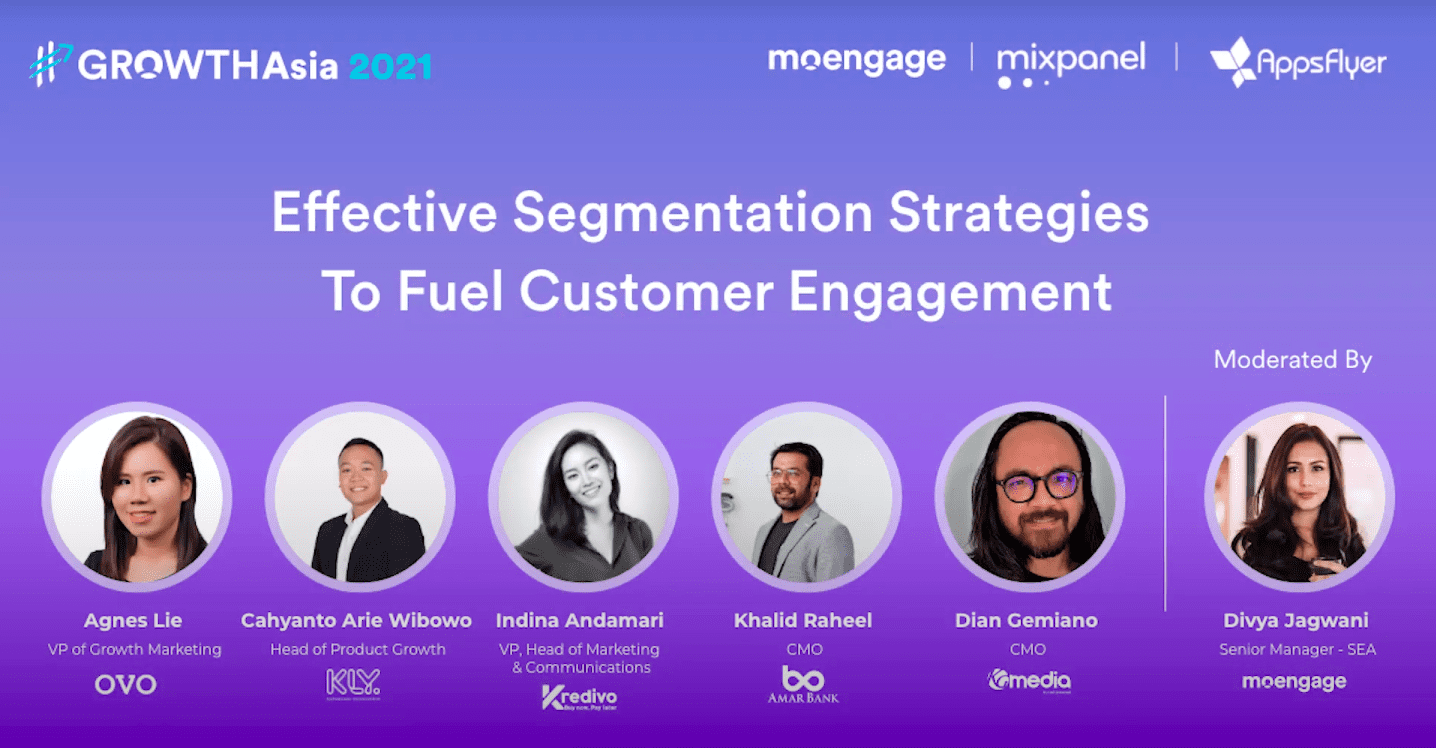
This session covers the various practical and efficient segmentation strategies that can be the biggest game-changer when it comes to driving customer engagement. It also highlights the importance of having an impactful segmentation strategy, shedding light on diverse segmentation strategies used by various industries.
Actionable Takeaways:
- Segmentation as an engagement tactic is of prime importance with organizations that segment effectively experiencing higher profits than those who don’t.
The idea behind segmenting users is to provide a personalized experience instead of generic and spammy communication. - If you are just starting out, use unique preferences and behavioral patterns to build your segmentation campaigns. You can focus on behavioral patterns, year-on-year aggregated consumer data, current preferences (on a granular level), repeat behavior, purchase drivers, incentives resonating with the audience, and communication channel. For advanced segmentation, look at the user’s predictive lifetime value.
- To run a targeted campaign, look at the user journey and work backward depending on the business targets you are trying to achieve.
- Finally, when it comes to managing the thin line between personalization and privacy, GDPR works as the gold standard. Transparency with users is key and has to be embedded in the DNA of every organization.
Experts Insights:
Agnes Lie
- The most refined form of segmentation is the behavioral segmentation approach which entails dividing audiences based on how they act on our platforms from in-app behavior to actual transactions.
- It enables us to be more precise with our targeting and opens up room for A/B testing
- It yields better results because the treatment we are giving to the users is based on real data rather than using presumed knowledge
- It allows us to combine the behavioral data with both predictive and deterministic modeling to pursue business objectives
- When segmenting users, look at the product funnel journey and see where the traffic came from and if it was acquired through big channels such as TikTok, Facebook, Google, etc.
- Look at the different segments within the channels and study their behavior before you dive into data relating to a behavioral or transactional relationship.
Indina Andamari
- In addition to looking at the cash transaction behavior of the user, we map out the customer journey first and identify the key drivers of each stage. We then prioritize users based on which group would bring the biggest impact. It could be the size of the pool or the ones that are getting the highest revenue. The focus is to gather enough data to work with so that your hypothesis can be more accurate.
- We use a data science model to score the demographics, geographic, and psychographic information. This results in a heat map, which helps us to prioritize which segment to focus on. Once we collect this data, we profile each segment to get a user persona. Within that segment, we then see if you have similar characteristics and then personalize the messaging for when A/B testing with a control group. The idea is to test your hypothesis before you make it a full-fledged campaign.
Cahyanto Arie Wibowo
- Based on the user data collected, we bucket user data into three categories:
i) demographic data such as gender and age
ii) behavioral data to divide our user action and
iii) technographic data which is about which technologies our users use. - We use these factors to analyze our internal theme. You can also factor in metrics such as usage frequency or time on-site to bucket users on their state of engagement and activity, and improve your product’s features.
Dian Gemiano
- Since in the media industry, we cater to different target audiences, our segmentation tactics differ. At KG media, we have three groups: the flyby, the moderate, and the loyal. So we look into the content consumption behavior and truly understand what kind of content will resonate with them the most. The goal is to shift the fly by into moderate and moderate to loyal because the loyal customer gives you more revenue.
- For advertisers, we are more passive and surf to understand what the advertiser needs by looking at the basic demography, consumption behavior, and purchase intent segmentation.
Khalid Raheel
- When we look at the segmentation, the goal is to look at the need-based segments (people who ‘need’ a loan) but also factor in the outliers who are ‘want-based’ users (for example, someone looking to buy a second-hand phone and may be interested in a loan).
- At Amar Bank, segmentation tells us what our TG isn’t as it is equally important to understand what our customers don’t want in addition to grasping what they do want.
- From a segmentation standpoint, it is important to understand what is the need, what is the necessity, and what is the demand at every stage of life as all these three elements change continuously. Once the user data is in, you can focus on creating the relevant micro-moments in these people’s lives that are based on highlighting the demands and benefits for the user.
- Before you start your segmentation, start with empathy and understand what it is that the customer is lacking in his/her life so that you can fill that gap. It’s important to backward integrate the product to a forward integrated behavior or vice-versa.
Session 2: Leveraging User Insights to Boost User Retention
The session moderated by Arijeet Rana (Senior Manager, SEA, MoEngage) with Kushal Manupati (Head of Digital at Zilingo), Rajeshwari Kanesin (Innovation Manager at U Mobile), Joshua Tan (Head of CRM at NTUC), and Vineeth Kallarakkal (Head of Marketing at theAsianparent) as attending experts.
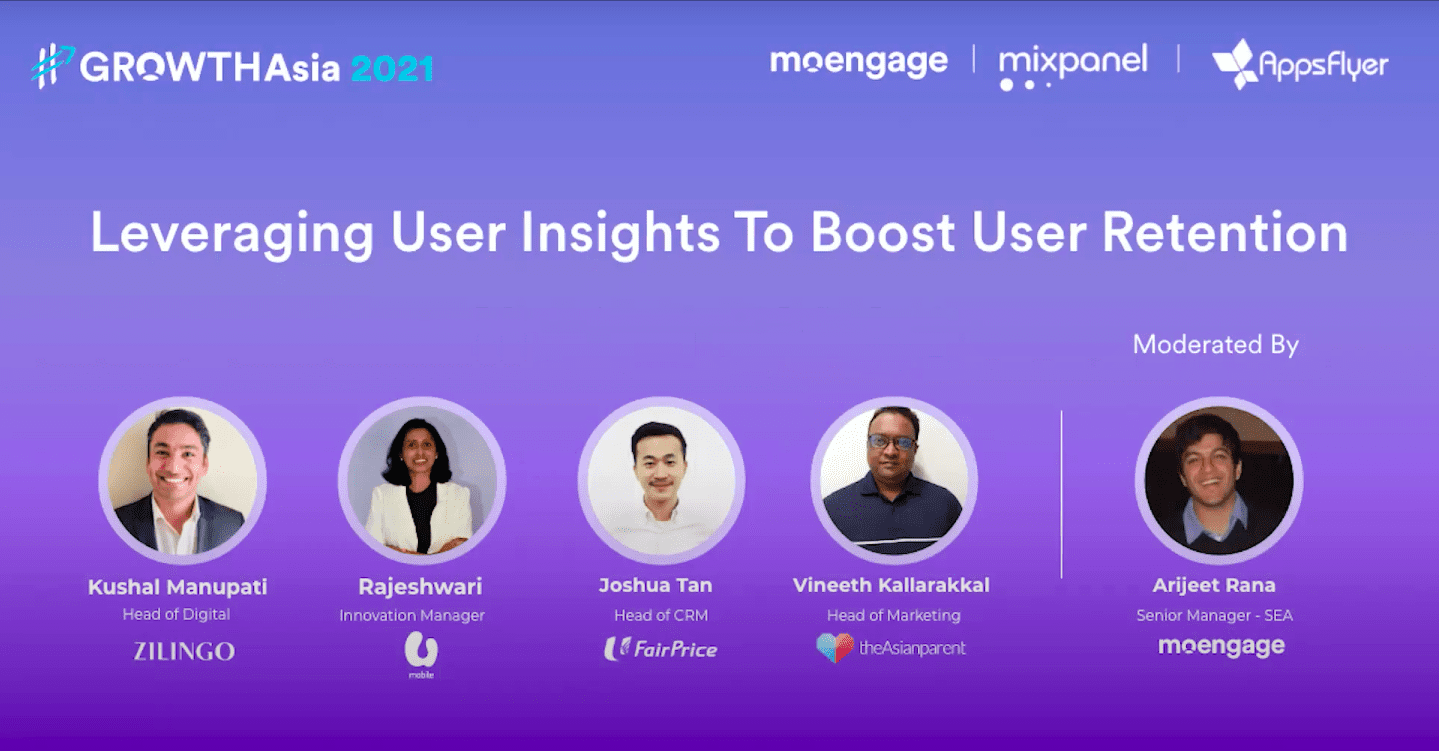
This session was centered around huge data volumes concerning user journeys and how they can be overwhelming for modern growth and product teams. The need of the hour is to avoid analysis paralysis by understanding the critical user insights that need to be monitored and how these insights tie into the larger goal of boosting engagement.
Actionable Takeaways:
- In today’s business landscape, customer retention is key. And one of the surefire ways to do this is by leveraging user insights to boost user retention. However, often, product teams and growth teams get lost in the mountain’s worth of user data and fail to understand what are the user paths that they should be following.
- So, the real question becomes: What are the most important engagement metrics you should look at and track? Some common options you can use include using the RFM model across the digital buyer journey, running gamification campaigns, analyzing your customer’s spending analysis, and looking at the typical marketing channels such as push notifications, SMS, etc.
- That said, user paths and user journeys are becoming more and more complex. So businesses need to understand the key user insights they’re trying to derive as well as key metrics that can help monitor engagement, and create a feedback loop between the lifecycle team, the marketing team, and the product team. Plus, they need to analyze what are the red flags for a user who’s about to churn so that you know the extremities of a life cycle of a user on your app/website/any other medium.
- This invaluable data can ultimately be used to drive user retention tactics via referral programs, greater personalization, optimal message frequency, building a like-minded user community, and so on.
Expert Insights:
Kushal Manupati
- Engagement metrics need to be looked into from the context of the stakeholder and across the different stages.
- The user journey is becoming more complex with the plethora of channels available and users have their own affinity towards a channel.
- It is important to have a good lifecycle framework to understand what life stage the user is in, understand where you want the user to go, and what relevant KPIs matter for that particular stage. You can use a robust tool to achieve all this and more.
Rajeshwari Kanesin
It’s important to actually have a separate user journey for different users so that you can classify them as “trusted,” verify them, and ensure that the user data is clean. You can then score the data accordingly.
Joshua Tan
- To understand the type of engagement metrics you should look at, first understand what is your ultimate North star goal that you’re trying to achieve.
- Then, look at what is the job of the channel that you’re using to reach that goal and understand how a user interacts with that channel, which becomes the engagement touchpoints that you want to really capture.
- You need to not just look at what engages the customer but also what disengages the customer.
Vineeth Kallarakkal
- Your engagement metric will differ based on the channel you are measuring–be it an app or a website. You also have to look at how you are catering to the different user stages. It’s also important to identify what kind of metrics make sense for your user segments and the tools that the user is using and then identify the data points accordingly.
- You need to build user journeys, map them out, and customize them because the wants of the users are changing at every stage. Building a proper path helps address different segments of users differently, and building a journey specifically for them ensures the stickiness of your product to the user.
- When evaluating the risk of churning, first look at the usage pattern and see if there is a decreasing trend in any of the usage of your product. Dig deeper and understand why user engagement dropped off.
Session 3: Building The Best-In-Class Customer Engagement Tech Stack
This session was moderated by Scott Pugh (APAC Director, Mixpanel) along with Bibaswan Banerjee (Director, CRM, Klook), Mark Birch (Startup Advocate, APJ, AWS), Khairold Safri Ibrahim (Digital Product Manager, TM), and Dr. Raymond Chan (Head of Data Science, Chope) as experts.
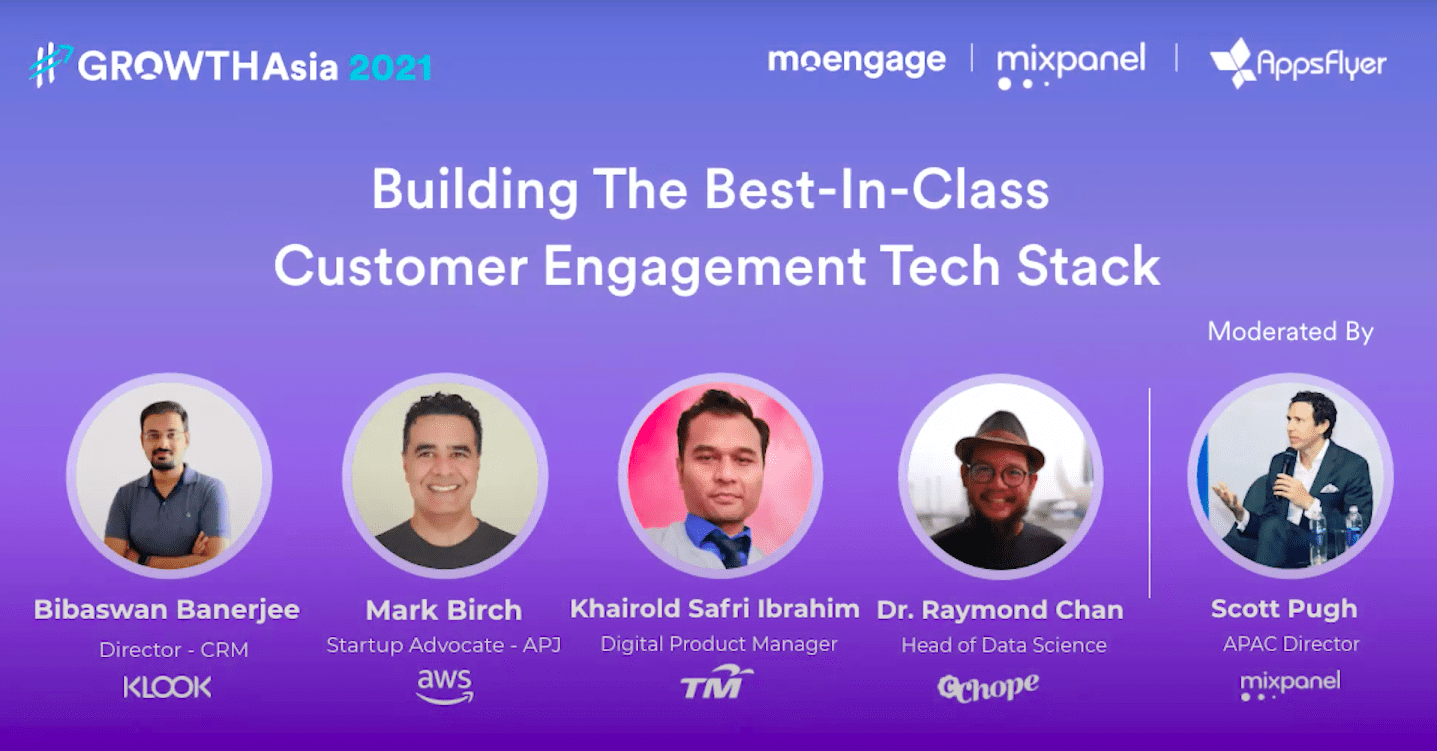
In this session, subject matter experts came together to discuss the evolution of the customer engagement tech stack and how to go about building a best-in-class tool that suits your business use cases.
Actionable Takeaways:
- There has been a paradigm shift in modern customer engagement, and subsequently, new technologies and tools have emerged to provide brands the much-needed cutting-edge.
- Whether you’re an early startup up or a traditional telco company, each company at different stages of their life cycle has to decide on what kind of tooling works for them at that specific time in their lifecycle. In other words, the customer engagement stack is ever-evolving and needs to be constantly monitored.
- It is important to hold your tech providers accountable and have a consistent dialogue going. When you’re buying technology, view it as an extension of your own team.
Expert Insights:
Bibaswan Banerjee
- The biggest challenge which we are constantly solving is how to stitch things together, as working in tech silos can be dangerous. Why? Because it paints an incomplete picture. So the key to using an ever-evolving tech stack is to ensure that as you get more and more new tools into the mix, you get them to talk to each other properly.
- When choosing a tech stack that offers scalability and customization, look for a stack that offers a solid foundation which big providers can provide through their cloud-based solutions. This can serve as the base. Then focus on having layers on top of that which are unique to your business. In short, leverage a hybrid stack to be more agile in customizing your solution.
- The trick lies in striking a balance between what you can onboard from the third party and which parts are critical to be super agile so you can work on it in-house.
Mark Birch
- Early-stage startups should focus on their core product and on getting the right features by using a consolidated tool that allows them to work as quickly as possible.
- In terms of the kind of tech stack to choose, remember that you should not be sacrificing the uniqueness of your offering and not diminishing the differentiation. So, look for a solution where you don’t have to build your own analytics.
Khairold Safri Ibrahim
- When zeroing in on a tech stack, the first question you need to ask is if it is even necessary in the first place, whether you need to automate those integrations or if they can be done manually.
- Another challenge you’ll need to tackle is changing the mindset of the people within the company to get them to try new things.
- You also need to keep the stack simple. Don’t try to do everything at once. Always start with the customers first rather than focusing on the technology, modeling or
the framework. - We learned that the attractiveness of the solution is only half of the story; the other half is making it work within the context of the company–taking into consideration the culture, the openness of the new technology, and of course, the resource availability.
Dr. Raymond Chan
- The main driver for our engagement stack was basically to understand how to achieve personalization through search and recommendation. To achieve this, we track behavior at a granular level, making the use of some kind of event tracking tool important.
- Here’s how we work: We feed a lot of the data collected into data warehouses and store it. We then build models that basically predict what interests the users. This information is then integrated back into the app, so our tech style is basically optimized through and through.
Session 4: Recalibrate, Recover, Reopen? Bouncing Back from the Pandemic
This session was moderated by Ronen Mense (President and Managing Director, APAC, AppsFlyer) with a panel comprising of Lakshmi Harikumar (Marketing Director, SEA, MoEngage), Dyah Wulandari (VP for Performance Marketing, tiket.com), and Alicia Vo (User Acquisition Lead, Amanotes).
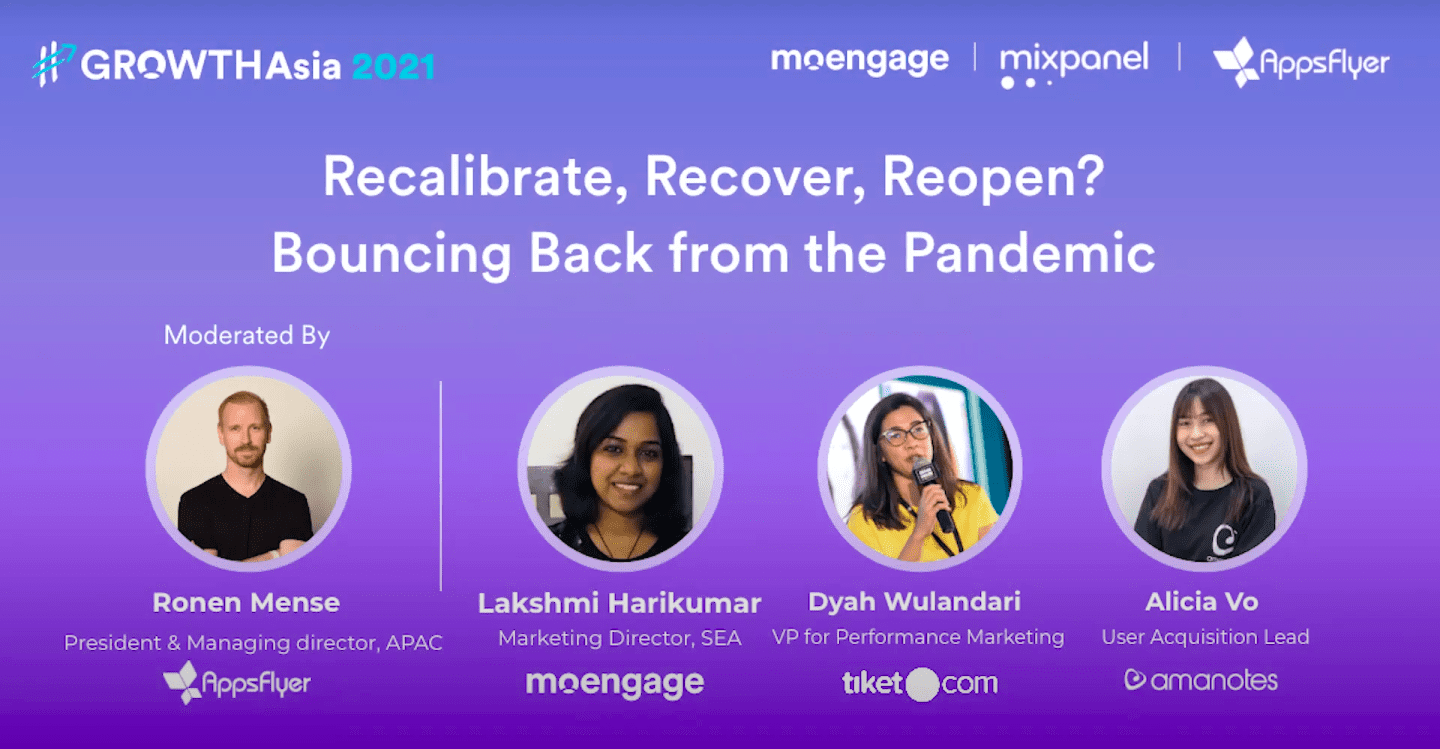
This session talks about what it will take for businesses to recalibrate, recover, reopen, and bounce back from the pandemic. It sums up how the pandemic has accelerated the digitalization of businesses by several years and answers the following important questions:
i) How are businesses recalibrating?
ii) Do businesses need to recover at all?
iii) What’s next for digital marketing with regions starting to fully reopen?
Actionable Takeaways:
- According to the recent AppsFlyer & iPrice report, the overall online spending among consumers in SEA increased by 19% in 2020–people who never bought online are starting to embrace online shopping. In other words, the pandemic has sped up the digitalization of businesses–not just by several weeks but years.
- It is important for businesses to reconceptualize their marketing initiatives and understand whether every segment and industry behaves the same. It is equally important to engage in ‘mindful marketing’ to the extent that you keep a happy tone but are not insensitive towards people’s feelings.
- Every brand might have a different reality, but the common theme going forward must be ‘positivity,’ ‘agility,’ and being ‘adaptive.’
Expert Insights:
Lakshmi Harikumar
- What helped brands differentiate themselves as winners are how agile they were in adapting their entire business model. It also involved not just looking at mobile as a channel but looking at mobile as a business model itself.
- A good example would be one of our clients in Australia, Jimmy, who’s in the online alcohol delivery service. He quickly added toilet papers to their entire supply of inventory, given the skyrocketing demand from the consumer. This is how brands can adapt and stand out in the long term.
- According to a report we recently published, one thing we’ve seen is this pandemic is the expedited adoption of digital and mobile. Traditional organizations were forced to go digital or go mobile, and organizations that were already digital had to completely reinvent themselves to break through the entire clutter.
- Going forward, businesses need to focus on innovative partnerships, business model changes, and keep the whole communication channel open with their customers. It is about being one with the consumers and being transparent about the business. For example, say your supply chain is broken right now, and order deliveries may be delayed. Communicating the same through increased transparency will help businesses reinforce their strong image and qualities.
- There’s been an increase in the marketing budget for obvious reasons. One, because brands want to maintain their share of voice and do not want to lose the momentum that they’ve built over all these years. And two, because paid activities have a direct impact on the organic traffic. All in all, they want to keep the whole brand positivity going right.
Dyah Wulandari
- Businesses need to be agile and focus more on short-term planning (say for the next three months). Plus, they need to be positive and redirect their focus on “maintaining people”, the biggest asset of the company.
- Our marketing strategy is to balance the needs of the user’s discovery phase up to the level when they make a purchase. From the marketing and the product point of view, we are empowering users with enough information within our apps to make sure that whenever they are in the ‘consideration’ phase, they can make the right choice.
Alicia Vo
- Along with driving light-hearted, warm, and cheerful campaigns centered around the “stay at home” theme, we have been sensitive to all the anxiety and stress that the users are constantly bombarded with. So, we ensure that our message is not too serious and basically want our users to use our apps for some much-needed escape.
- As a business, we need to establish a strong foundation with our partners with the industry, be it our marketing partners, our hotel partners, etc. to reinforce a strong business environment and offer mutual support.
- The communication and coordination between different stakeholders, both internal and external, can help maintain the effectiveness of your business and offer positive opportunities in the future.
What’s Next in Store?
Since #GROWTHAsia 2021 broadly covered topics around customer centricity, effective segmentation, leveraging user insights and boosting retention, building modern-day customer engagement stack, and bouncing back from the pandemic, here are a couple of articles you should check out:
- 11 steps to building a customer-first culture
- Learn how to better segment users via RFM
- How to measure retention using cohort analysis
- Modern customer engagement platform: Should you build or buy?
- Actionable bounceback frameworks for the post-crisis business world
- 30+ Pertinent Marketing Questions Answered by Industry Experts







